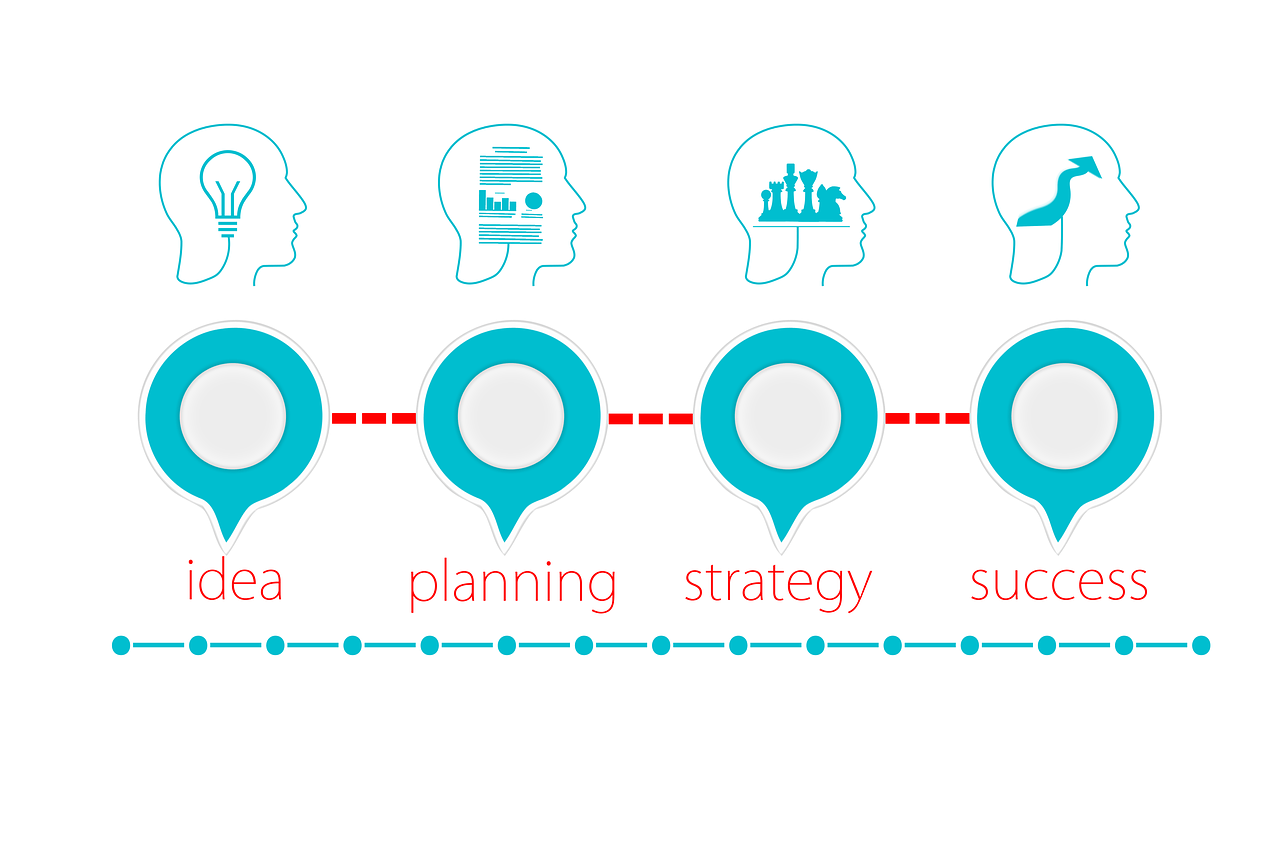The Success of Your Business Starts Here
If you master these 3 pillars: Finance, Sales Marketing and Operations, the Success of Your Business is right in front of you.
Many of us have projects, but few of us actually make them happen. The reason is quite simple. Faced with the administrative complexities and the investment necessary to create a company, we become discouraged in advance. What if it didn’t work? What if I wasn’t up to it? What if the risk was too great? So many questions that make us miss great opportunities, because we fear the mountain that stands in front of us. The success of your business depends on these main departments:
Finance Department
The finance department of a company is the engine of a business. This must be properly organized to ensure the proper functioning, development of the firm and the success of your business. Structuring your financial department in good and due form means guaranteeing the company’s investment possibilities, ensuring that employees and collaborators have the necessary financial means to carry out their professional missions, but it is also the best way to control expenses and reduce unnecessary costs to zero.
Faced with the challenges and changes in the finance function, it is essential to have advanced skills. The training offer has developed significantly, offering solid qualifications.
What is the role of finance in a company?
Finance has one objective: to maximize the value of the company for its shareholders in the long term. In other words, it is about maximizing profits over a relatively long time horizon while limiting the risks involved. Corporate finance is therefore interested in investment decisions, financing and remuneration of capital providers.
Ensure the sustainability of the company
The finance function allows the company to have the funds necessary for its development. To this end, it intervenes in decision-making by sharing its recommendations on the best financing for carrying out an operation.
Risk management
The notion of risk is inseparable from the arbitration between the different sources of financing (self-financing, borrowing). It also establishes financial ratios that allow the company to take stock of its financing capacities and implement its development strategy. We are interested here in profitability, but also in solvency and liquidity.
Decision support
Any decision involving a financial flow must be taken after consultation with the financial management, whether it is a manager or a decision-maker. It is a financial, budgetary, strategic and communicational function, which implies having several strings to one’s bow to succeed.
The evolution of corporate finance
Many studies have focused on the evolution of the financial function over time. For three decades, finance has gradually become ubiquitous, beyond business, marketing, technical and technological cycles.
The digitalization of finance
The finance function has obviously begun its digital transition. The evolution of tools and technologies makes it possible to meet many objectives, namely:
- speed up treatment and lower costs;
- streamline exchanges between all stakeholders;
- manage risks and legal certainty;
- drive performance;
- reinforce the added value of the finance function.
Corporate finance now has a wide range of tools at its disposal that allow it to evolve. This is particularly the case with artificial intelligence, which makes it possible to automate certain tasks and dematerialize documents. The company then gains in efficiency and reduces its costs. This technology also makes it possible to analyze increasingly large volumes of data, which provide a new view of financial activity.
We can also mention the blockchain, thanks to which transactions are simplified and secure, or the Cloud, which is very useful for planning and budgeting operations.
Constant evolutions
The projects were mainly evaluated on their strategic and operational aspects. Today, they are above all by their financial aspect. The volatility of the economy has a lot to do with it, but the increase in competitive intensity resulting from globalization is no stranger to this hegemony either.
The digitization of corporate finance has also led to profound changes, particularly in terms of business lines, which are now characterized by a strong notion of analysis and advice. These new skills are now very popular with recruiters.
Corporate finance professions
The corporate finance function is characterized by a wide range of profiles and numerous professional opportunities. You will thus be able to access various professions.
Management professions
the financial director: he defines and steers the financial and budgetary strategy of the company;
the administrative and financial director: he ensures the proper execution of the strategy put in place by the management as well as of the procedures. He must also coordinate the various departments;
the accounting director: he is the guarantor of the reliability of a company’s corporate and consolidated accounts. It ensures that they comply with the standards in force.
Finance professions
- the credit manager: he is in charge of risk management;
- the tax lawyer: he ensures that the company complies with the legislation in force at the legal and tax level;
- the person in charge of financial communication: he ensures the relationship between the company and investors, shareholders or any other financial player;
- the treasurer: he is the guarantor of the company’s liquidity.
Accounting professions
- the auditor: his mission consists mainly in certifying the annual accounts of a company;
- the consolidator: he analyzes and verifies the accounting and financial data in order to draw up a financial statement that reflects the real economic situation of the company;
- the chartered accountant: he ensures the reliability of the company’s accounts by ensuring that they comply with legislation (accounting, tax and social);
- the accounting manager: he produces and supervises the financial statements of the company. It is also he who ensures the proper application of accounting standards;
Advisory and control businesses
- the internal auditor: he carries out various audits in order to assess the situation of the company and enable it to achieve its objectives;
- the finance functional consultant: he assists the company with advice in setting up its information system;
- the management controller: he analyzes the financial and economic situation of the company to communicate it to its management with the aim of helping it in its decision-making;
- the risk manager: his expertise enables him to help the company take controlled risks.
The Sales and Marketing function
The Marketing and Sales function is the function that is most in contact with the consumers that we are.
A few meters in the street are enough to encounter advertising posters, and a few meters in a store are enough before encountering a salesperson!
This function is increasingly important in companies because it improves their results.
The Marketing and Sales function: what definition for what issues?
The definition
The Sales and Marketing function brings together all the activities and processes allowing a company to:
understand consumer expectations and the market situation in which it operates;
to try to influence the behavior of consumers in the direction of its objectives.
What issues?
The importance of the Marketing and Sales function can be understood at several levels:
- From a financial point of view, market studies make it possible to best choose the products that will be the most profitable for the company.
- On the commercial level, a good study of consumer expectations will make it easier to sell products.
- On a strategic level, the Marketing and Sales function makes it possible to avoid confrontation with competitors by selecting the customers and products most suited to the characteristics of the company.
What tasks within the Marketing and Sales function?
The Marketing and Sales function is divided into two main types of tasks, which are upstream and downstream of product design.
Upstream of product design: strategic marketing
Before designing a product, the company must ask itself what consumers want.
- to understand consumer expectations and the situation of the market in which it operates
- to try to influence the behavior of consumers in the direction of its objectives.
Its objective is therefore initially to better understand the market in which it intends to sell its product.
The company is then looking for two types of information:
- what consumers expect: what are their needs? what do they like in the products? how do they eat?
- what the competitors are doing: who are the competitors? what products do they sell? At what price ? to which customers?
Once this information has been collected, the company will decide what its positioning will be.
The company will therefore define what will be the specific characteristics of the product in order to make it unique in the minds of future consumers.
Downstream of product design: operational marketing and sales
Once the prototype of the product (or service) has been designed, we enter the operational marketing phase.
There are four major variables on which to act.
The 4 Ps: Product – Price – Place – Promotion:
- The Product variable (product): it is a question of seeing which characteristics of the product are the most important for the customer: size, quality, lifespan, etc.
- The price variable (price): it is a question of determining the price which will make it possible to sell large quantities of the product without degrading its image in terms of quality.
- The Distribution variable (place): this involves determining the distribution channels (i.e. the types of stores) in which the products must be sold. If the stores are not suitable (selling sneakers in a hair salon), sales will be lower.
- The Communication variable (promotion): this involves making the product known to as many people as possible by using the most appropriate advertising media (television, internet, radio, mail).
The Marketing function: debates and perspectives
Marketing and Ethics
The ability of the marketing function to understand and influence consumer behavior is not without its problems.
Since the 1970s, consumer associations have highlighted the dependence of certain customers on brands and the dangers of the omnipresence of advertisements.
Some people do not hesitate to go into massive debt to buy products that they do not need, but that advertisements make artificially indispensable.
Looking for loyal customer
Even if the Marketing function, as an independent function, is relatively recent, it has nevertheless undergone some changes.
Until the 1980s, sales and distribution were essentially done in a single transaction logic. But companies have realized the need to keep customers loyal to their brand and their products.
Indeed, it is much less expensive for a company to keep a loyal customer than to get a new customer. The focus is now on the relationship with he customer, to ensure that he is satisfied and that he is ready to buy back the company’s products. We then speak of relationship marketing.
Operations Department
Every business has an operations department to ensure the smooth running of its day-to-day business. This service focuses primarily on maintaining the efficiency of the production process and helping teams make the right choices. In this article, discover the 7 functions of operations management and the main missions of dedicated teams.
The Director of Operations is responsible for the operational strategy of the company within which he operates. He is in charge of optimizing turnover and margins, but also of participating in the development of the activity by anticipating market developments. He reports directly to the general management.
But to each his own! You will not monitor the weather, nor air movements and even less the communications of the pilots! Indeed, operations management is mainly based on the following 7 functions:
1. Operational planning
It will be much easier to maintain the efficiency of operational processes if you show a little ingenuity. As an operations manager, you will have to manage your team by promoting the interests of the company at all costs. To deal with the changes that will be necessary, you will have to think quickly and wisely. Are you faced with a crisis situation and do not have the necessary tools at your disposal? Brainstorm, and fast! Eventually you will find a solution worthy of your ingenuity.
Operational planning is the fundamental function of operations management and includes the following tasks:
- Ensure the daily monitoring of the production of goods
- Manage and control your inventory
- Keep an eye on the performance and well-being of your team members
- Plan all operations
Simply put, the main function of operations management is to maintain operational efficiency. Always be on the lookout for the latest trends to overcome obstacles and constantly improve your operational strategy.
2. Finance operational management
Financial operation planning involves determining whether or not your business has the budget to achieve its strategic goals. There is no secret, no financial success without budget planning!
Keep production costs low by finding quality suppliers at affordable prices. This will allow you to create a product of choice, without exceeding your client’s budget.
Essential and universal, the financial aspect is not to be taken lightly either. Indeed, every business strives to reduce its costs and increase its profits as it can. Nothing new so far! As an operations manager, you will ensure that your management takes full account of the company’s budget when it comes to making important decisions. But not only ! You will also need:
- Establish budgets to meet production goals
- Look for investment opportunities
- Allocate budgets and manage resources
You’re probably wondering how the finance responsibilities of the operations team differ from those of the finance department. It’s very simple, it’s the finance department that takes care of everything, from the management of the company’s income to the distribution of wages. As for you, your role is only to manage the financial operations related to the production process.
3. Product design
To land at this position, it is essential to know how to interpret data correctly. As an operations manager, you must deduce from your data clear directions to communicate to designers, in order to intelligently place your product on the market, and if possible, outperform the competition.
Once your plan is developed, simplify communication between teams using a dedicated platform or tool. Create a central project plan to track all the actions to be implemented as well as relevant information and comments. Then share it with your whole team using a project management tool so everyone can easily access it and track changes in real time.
Product designers may be the artists on the team, but operations team members are budding spies. Indeed, always looking for the slightest information on the market, they carry out the investigation like no one else. Once customer needs and market trends have been clearly identified, it is up to the designers to take over and create the product of the century!
In this role, the tasks you and your team will be responsible for include:
- Conduct market research and derive actionable results
- Communicate all of your results to the product design team
- Provide clear direction to designers
Without the operations team, it would be very difficult for the product design team to know which direction to go. And yes, the market is constantly changing! A successful finished product therefore requires extensive research and inspection of every corner of the industry.
4. Quality Control
The meshes of this process will tighten around certain products, and this, as many times as necessary. Indeed, several round trips between the design team and the quality control team will sometimes be required to fully meet the desired quality standards.
As annoying as they are, these exchanges will lead to the best possible version of the product you want to launch. To excel at this, develop strong conflict management strategies. You will thus cross with more serenity the phases of turbulence and will create products which will be a hit!
Quality control goes hand in hand with product design. Logic. Indeed, once the production team has created a product, the operations team ensures that it meets the desired quality standards. Testing the product before it is put on the market is therefore essential to guarantee that it does not present any defects. As a member of the operations team, you will for example:
- Perform risk analysis to identify potential product issues
- Carefully review each product to ensure quality standards are met
- Carry out tests to control the quality of your products
- Document any defect or malfunction of the products
The level and standards of quality control vary from industry to industry. This is why the first instinct of your team must be to carry out market research to clearly identify them. Once these standards have been defined, they will serve as a reference for the quality management of future projects.
5. Activity forecast
Mastering the art of data-driven decision-making will serve you well in many aspects of operations management. To predict the future most effectively, put away your crystal ball and rely on facts. Start by estimating product demand by analyzing past trends, then communicate your informed conclusions to department heads. They will then adjust their plans accordingly.
To ensure your success, forecasting is essential. Far from any meteorological consideration, it is above all a question of forecasting product demand. For your operations management team to excel in this role, it may be helpful to consider the following questions:
- What will be the demand for this product in the future?
- What marketing and promotional operations should we plan for this product?
- What commercial initiatives should we plan for this product?
- Are the storage costs of this product estimable? If so, what are they?
- What would be the costs of supply and raw materials?
6. Strategy
Thinking critically is very important when it comes to strategy. It is by developing it that you will refine your way of thinking and think with discernment. Use your logic and develop solid strategies that you can rely on to achieve your goals. Likewise, base your ideas on research and data and ensure you make the right choices for your team.
The strategic aspect of operations management is very broad and concerns many areas such as planning, monitoring and analysis of operations. The objective of strategic management is to ensure that production decisions are fully aligned with the company’s business objectives. These business objectives can be the following:
- Make customer satisfaction the number 1 priority
- Improve the production system
- Control costs while maintaining a competitive advantage
Your job as an operations manager is to find ways to achieve your company’s business goals. Here are some strategies that you could for example implement:
- Analyze your inventory: To prioritize customer satisfaction above all, start by analyzing your entire inventory. Assuring them that you are able to respond to their request in all circumstances is an excellent way to build loyalty.
- Encourage teams to collaborate: the more you encourage collaboration between teams, the more effective communication will be! This will improve the production system and reduce the margin of error.
- Prioritize green processes: Using more environmentally friendly processes can help you save money in the long run and increase consumer loyalty.
7. Supply chain management
As an operations manager, you will not only have to organize, plan and delegate, but also solve problems without procrastinating! Many strategies exist in this area, it is up to you to study them and adapt them to the situations you encounter. Rest assured, your team members will greatly appreciate it.
Whether your company offers products or services, effective management of its supply chain will obviously be necessary to enable it to obtain the raw materials it needs, produce and finally ship. Sometimes consisting of a service in its own right, it is up to you to manage the supply chain linked to internal production, which responds to a particular cycle:
- Raw materials
- Vendor
- Production/manufacturer
- Distributor
- Retailer
- Consumer
The supply chain works cyclically. Indeed, once the consumer demand has been analyzed, you will have to source more raw materials and go back down the chain. It’s go again !
It is not always necessary to follow each of these steps to the letter. For example, if you work in a small business, you can get your products or services directly to consumers and can reduce distribution and retail costs. However, you will have to be careful to keep your supply chain intact, since a simple bottleneck in one of its stages would be enough to wreak havoc and have serious repercussions on the whole process.
Sources: Investopedia
Photo credit: geralt via Pixabay
Ready to get started?
Are you a consultant? If you are a consultant and wish to contact us for any reason, we invite you to click the ‘Let’s Get in Touch’ button to connect with our team and receive the necessary assistance.
Are you in need of appropriate and objective advice? Feel free to click the ‘Request for Proposal’ button to contact us and discover how we can assist you today.







